Swindler Cove Park & Sherman Creek
by Ben Cacace
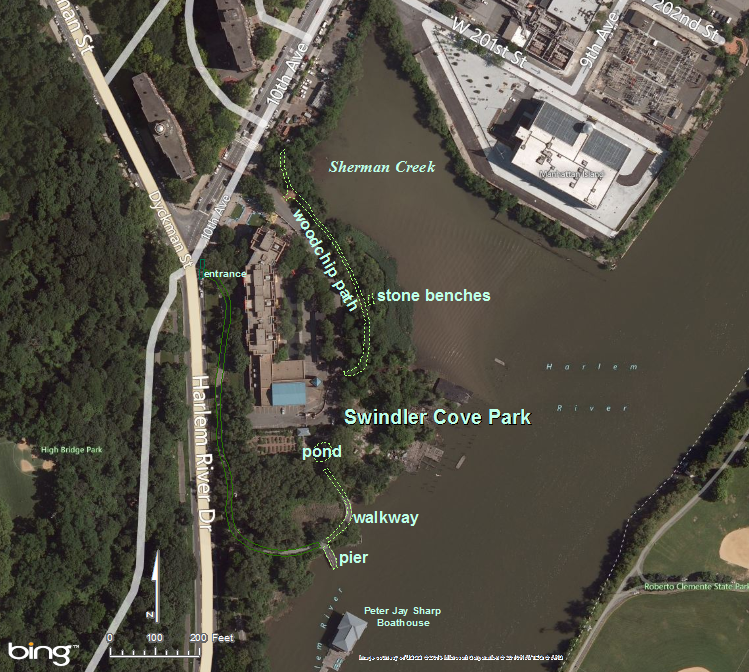
Also see Ben’s Google map
The New York Restoration Project (NYRP), headed by the multi-talented entertainer Bette Midler, has brought this northern Manhattan park area back from a dump site to one of the most beautiful small parks in the city. From 1996 to 1999 the NYRP cleaned up the area, removing tons of debris including garbage, construction debris, old cars and boats. Access to the site is from 10th Avenue and Dyckman Street where Public School 5 meets Sherman Creek. Going east on Dyckman, Swindler Cove is south on the bike path/walkway that parallels the Harlem River Drive. Coming from the north on 10th Avenue through the school’s driveway, a short walk along the woodchip path bordering Sherman Creek leads to Swindler Cove Park proper. This park borders the Harlem River and features a saltwater marsh, a small freshwater feature and various nest boxes installations.
At low tide Sherman Creek is an excellent draw for shorebirds and waders in the fall and spring. This location is not as frequently birded as other sites in the city so a lot is yet to be learned from birders on future visits to the site.
Birds
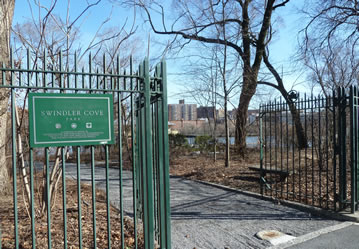
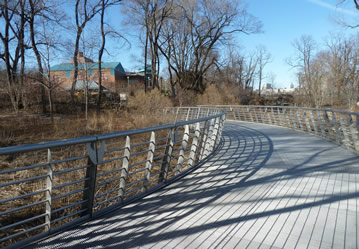
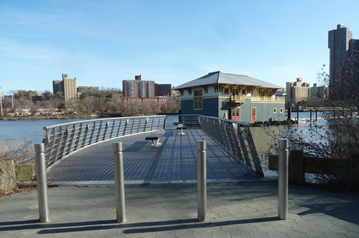
Birding along Sherman Creek is best from three locations. At the west edge of the creek a short walk down to the mudflats along the fence near the northern entrance can be a great place to view migrant shorebirds, Black-crowned Night Herons, Great Egrets and Great Blue Herons. The shorebird list for the site includes seven species, with Spotted Sandpiper, Least Sandpiper, Semipalmated Sandpiper and Killdeer the most commonly seen. This is one of the few places in Manhattan where peeps and other shorebirds can be found on a regular basis in season. The middle of the path (where the Stonehenge-like benches form a semicircle) has an opening to an overlook where most of the creek can be viewed. The third location is at the end of the path along Compost Alley, where the park does its composting. This is a favorite place as the tide starts to fall. Past this area is the high point of the mudflats, and it is the first exposed spot. Sitting here quietly can give exceptional views of feeding shorebirds.
Yellow Warbler has nested here the two years I’ve birded the site. A nest was located east of the overlook along Sherman Creek viewable from the woodchip path. Currently the warblers in the fall have been more numerous than in spring, but this should get sorted out as the park gets more checklist submissions. Mourning Warbler has been seen in the fall along with Ovenbird, Northern and Louisiana Waterthrushes, Blue-winged and Nashville Warblers, along with the other common warblers seen in the city. Two Orange-crowned Warblers lingered here one winter.
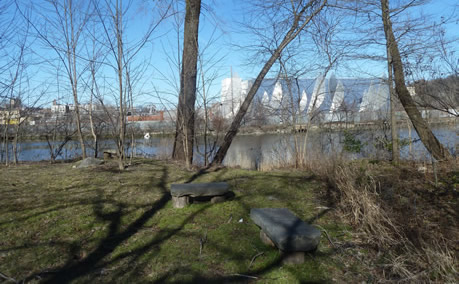
This park is not a great draw for sparrows as only six species have been seen to date: American Tree, Fox, Song, Swamp, White-throated Sparrows and Dark-eyed Junco.
Local raptor sightings include Red-tailed Hawks, Peregrine Falcons and American Kestrels. In the fall, migrant raptors seen have included Bald Eagles, Red-shouldered, Sharp-shinnedand Cooper’s Hawks, Osprey and Turkey Vultures. The ridge formed by nearby Highbridge Park may be a good draw for hawks in the fall. Viewing is best from the Sherman Creek overlook and at the “pier” near the Peter Jay Sharp Boathouse.
At the small freshwater feature in Swindler Cove Park on a day when the swallows and swifts are numerous, some will come down to the very small water body to drink. Sitting down on the benches when taking a break is usually when I’ve seen this happen.
Other Considerations
View Larger Map | Get Directions
The park is lightly used and portions of Sherman Creek are isolated. As in many city parks and neighborhoods, you should be aware of your surroundings. Bird with a friend or group if you want to be on the safer side.
Check the NYRP website for park hours and holiday closings. To get tide information do a search for tides at the University Heights Bridge, Harlem River.
Directions
Take the 1 train to Dyckman Street, walk east on Dyckman Street a quarter mile and cross 10th Avenue. From the east side of Manhattan you can take the Metro North Hudson line to University Heights and walk over the 207th Street bridge, then south on 10th Avenue, for a total of three-quarters of a mile.

